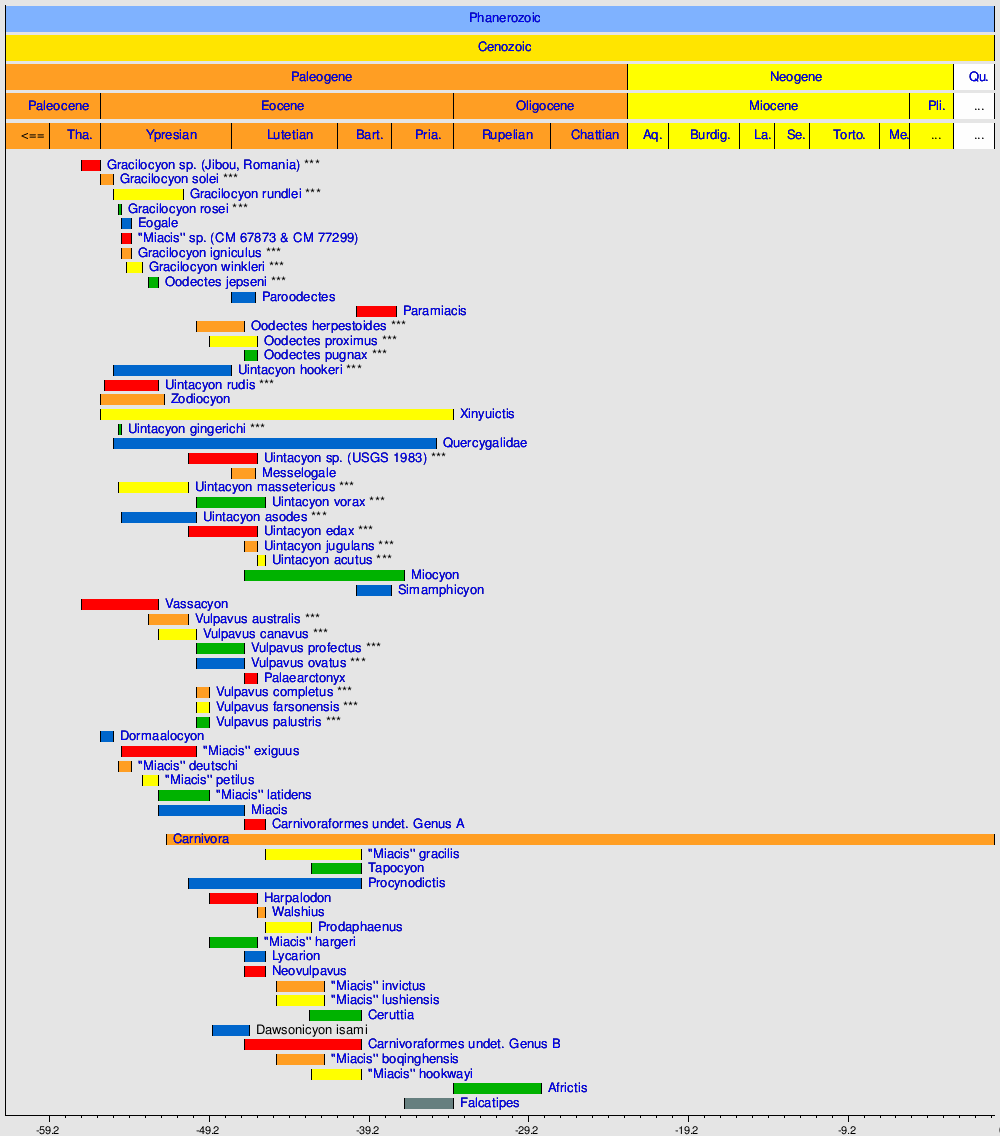Dawsonicyon
izumrli rod placentalni sisara
Dawsonicyon (Давсоникион — „давсонин пас”) је изумрли род плацентални сисара из кладуса Carnivoraformes, који је у периоду од раног до средњег еоцена настањивао подручје Сјеверне Америке.[1][2]
| Dawsonicyon Временски распон: рани до средњи еоцен
| |
|---|---|
| Научна класификација | |
| Домен: | Eukaryota |
| Царство: | Animalia |
| Тип: | Chordata |
| Класа: | Mammalia |
| Кладус: | Pan-Carnivora |
| Кладус: | Carnivoramorpha |
| Кладус: | Carnivoraformes |
| Род: | †Dawsonicyon Spaulding, Flynn & Stucky, 2010[1] |
| Типска врста | |
| †Dawsonicyon isami Spaulding, Flynn & Stucky, 2010
| |
| Врсте | |
| |
Етимологија назива
уреди| Род: | Поријекло назива од: | Значење назива: |
|---|---|---|
| Dawsonicyon | давсонин пас |
| Врста: | Поријекло назива од: | Значење назива: |
|---|---|---|
| D. isami |
|
исамов Давсоникион |
Систематика
уредиКласификација
уреди| Врста: | Распрострањеност фосила и локација: |
Временски распон: |
|---|---|---|
| †D. isami (Spaulding, Flynn & Stucky, 2010)[1] | САД (Вајоминг) | 49,0 до 46,7 мил. год. |
Филогенија
уредиДоље приказан кладограм представља филогенетске везе рода Dawsonicyon.[3][4][5][6]
| Carnivoramorpha |
|
†Gracilocyon/Oodectes група †Vulpavus група | ||||||||||||||||||||||||||||||||||||||||||||||||||||||||||||||||||||||||||||||||||||||||||||||||||||||||||||||||||||||||||||||||||||||||||||||||||||||||||||||||||||||||||||||||||||||||||||||||||||||||||||||||||||||||||||||||||||||||||||||||||||||||||||||||||||||||||||||||||||||||||||||||||||||||||||||
| (Carnivora [sensu lato]) | ||||||||||||||||||||||||||||||||||||||||||||||||||||||||||||||||||||||||||||||||||||||||||||||||||||||||||||||||||||||||||||||||||||||||||||||||||||||||||||||||||||||||||||||||||||||||||||||||||||||||||||||||||||||||||||||||||||||||||||||||||||||||||||||||||||||||||||||||||||||||||||||||||||||||||||||||
Временска распрострањеност рода Dawsonicyon унутар кладуса Carnivoraformes
уреди
Види још
уредиРеференце
уреди- ^ а б в г Spaulding, Michelle; Flynn, John J.; Stucky, Richard K. (2010). „A new basal Carnivoramorphan (Mammalia) from the ‘Bridger B’ (Black’s Fork member, Bridger Formation, Bridgerian Nalma, middle Eocene) of Wyoming, USA”. Palaeontology. 53 (4): 815—832. doi:10.1111/j.1475-4983.2010.00963.x.
- ^ Tomiya, Susumu (2011). „A new basal caniform (Mammalia: Carnivora) from the Middle Eocene of North America and remarks on the phylogeny of early carnivorans”. PLoS ONE. 6 (9): e24146. PMC 3173397 . PMID 21935380. doi:10.1371/journal.pone.0024146.
- ^ Flynn, John J.; Finarelli, John A.; Spaulding, Michelle (2010). „Phylogeny of the Carnivora and Carnivoramorpha, and the use of the fossil record to enhance understanding of evolutionary transformations”. Ур.: Goswami, Anjali; Friscia, Anthony. Carnivoran evolution. New views on phylogeny, form and function. Cambridge University Press. стр. 25–63. ISBN 9781139193436. doi:10.1017/CBO9781139193436.003.
- ^ Solé, Floréal; Smith, Richard; Coillot, Tiphaine; de Bast, Eric; Smith, Thierry (2014). „Dental and tarsal anatomy of Miacis latouri and a phylogenetic analysis of the earliest carnivoraforms (Mammalia, Carnivoramorpha)”. Journal of Vertebrate Paleontology. 34 (1): 1—21. ISSN 0272-4634. doi:10.1080/02724634.2013.793195.
- ^ Solé, Floréal; Smith, Thierry; De Bast, Eric; Codrea, Vlad; Gheerbrant, Emmanuel (2016). „New carnivoraforms from the latest Paleocene of Europe and their bearing on the origin and radiation of Carnivoraformes (Carnivoramorpha, Mammalia)”. Journal of Vertebrate Paleontology. 36 (2): e1082480. ISSN 0272-4634. doi:10.1080/02724634.2016.1082480.
- ^ Tomiya, S.; Zack, S. P.; Spaulding, M.; Flynn, J. J. (2021). „Carnivorous mammals from the middle Eocene Washakie Formation, Wyoming, USA, and their diversity trajectory in a post-warming world”. Journal of Paleontology. 95 (Supplement S82): 1—115. doi:10.1017/jpa.2020.74.